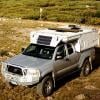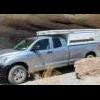Quick question, what is this?
#41

Posted 12 April 2012 - 02:28 AM
It is attached to a Thule front rack. The camper is on the truck full time, so I think over the course of some 50,000 miles, it has probably saved me a few bucks in gas not to mention kept about 100 pounds of bugs and crap off of the front of the camper. Right away I noticed a dramatic decrease in wind noise and buffeting at highway speeds, especially in head winds or with semis coming the opposite direction on a two lane road.
It also helps to keep crap off of the solar panel that slides out from underneath the cab and I can store lightweight things behind it via lashing points. There is plenty of clearance for bed flex too and it comes off in less than a minute for cleaning / maintenance purposes.
It truly makes for a smooth and quiet ride.......frankly, it just plain works.
#42

Posted 10 May 2012 - 05:15 AM
Still, they're a lot more accurate than the predictions of economists and other financial experts...
Of course...that also means that my retirement savings have to last longer...
Real economists don't make forecasts or predictions they report facts. Economic forecasters are making guesses just like most forecasters, including your local weather forecaster. Sometimes they may be right the next day, but ask them to forecast what the weather will like in 1 year, 5 years or 10 years to the day?
Roger
Sorry for the rant, long day.
Edited by Roger, 10 May 2012 - 05:18 AM.
#43

Posted 10 May 2012 - 05:23 AM
A little off-topic, seems like...Real economists don't make forecasts or predictions they report facts. Economic forecasters are making guesses just like most forecasters, including your local weather forecaster. Sometimes they may be right the next day, but ask them to forecast what the weather will like in 1 year, 5 years or 10 years to the day?
Roger
Sorry for the rant, long day.
FWC Hawk (2005) on a Ford F250 Supercab, 6.8L V10 gas (2000)
#44

Posted 10 May 2012 - 02:12 PM
Ever notice how soft tonneau covers, when at speed, have just a mild depression formed in them rather than being randomly and erratically whipped about? Air is compressible. (Thanks, Capt. Obvious?) What he said was that the air in the bed, as contained by the tailgate & bedsides, is being mildly compressed by the higher speed air flowing off the rear of the cab roof. So long as the bed doesn't "leak" this compressed air too badly IT forms a "tonneau cover" and the higher speed air off the top of the cab will flow across the top of it. There is some surface tension and turbulence involved, so it's not perfect. Anyone else noticed the trend in late model pick-ups to seal the tailgate to the bed? I recall a Ford Ranger that had actual rubber flap seals up the sides. The OE's aren't dummies, and they have wind tunnels to play with. Someone, somewhere noticed something and they're using it to gain mileage.
Take the classic shape of a falling water drop. It isn't an accident that it's shaped like that, the air that it is moving thru shapes it that way. I would bet that any higher density, high surface tension fluid moving thru a lower density, low surface tension fluid would behave exactly the same way. So, with that webby-thingy in place of the tailgate the surface area from turbulence induced drag just about doubled. There's probably a power or a factor in there somewhere that says that the drag incurred is some exponent or multiple of the increase in the area, but I'm not an Aero. Viewed from the rear the total cross sectional area is the same with or without the tailgate. With the tailgate in place though the transition is more gradual, more like that falling water drop. So the drag is reduced. Any of you ever towed a 'dinghy' and been amazed that it didn't cost you as much mileage as you thought it would? Towing my old 'glass dune buggy behind my '66 Econoline Van actually improved my highway mpg (jumped from an average of 10 clear up to 11!!!) Like the 'tail' on the water drop, the 'dinghy' and the buggy filled in a highly turbulent area and smoothed out the airflow over the vehicles.
So, about an air dam(n) up front, I think that a deflector up front is a good idea, but I also think that filling in the sides is desirable to keep drag from occurring on it's backside by creating a vacuum. Like the tailgate, if you put up just some dams that contain the 'compressed' air from escaping off to the sides with an open front then a deflector may not be needed since the 'compressed' air will form that for you, but that would sure look odd. And as soon as there is an air 'leak' then you'll need the frontal face. Look at the deflectors used in the trucking industry on top of the cabs of the bob-tails. That shape isn't an accident either. A hemisphere is the greatest volume for the least surface area. That the trucking deflectors are semi-hemispherical isn't a surprise to me. Smooth, laminar airflow is the goal to reducing drag. Any sharp change in direction promotes turbulence, which is (a) drag.
Where does that road go?
#45

Posted 05 January 2015 - 04:34 AM
2015 FWC Hawk
M416 Expedition Trailer
Bayleaf Woof!
0 user(s) are reading this topic
0 members, 0 guests, 0 anonymous users

















